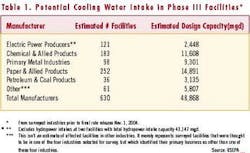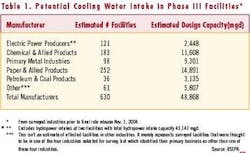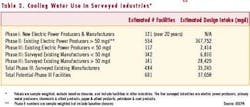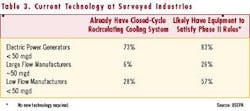Phase III of Cooling Water Intake Rule Released
By Managing Editor Carlos David Mogollón, Editor
Looks as if big industry slipped under the radar with the release Nov. 1 of Phase III of proposed rules governing cooling water intake structures, known as Section 316(b) regulations under the Clean Water Act.
Phase III could have covered "certain existing facilities and new offshore and coastal oil and gas extraction facilities," including manufacturers and electric power producers using down to 2 mgd of water. Among three options proposed, however, the least onerous only affects those withdrawing 50 mgd and above. Below that, what to allow is left largely to the "best professional judgment" of the NPDES permit writer.
As a result, one power industry representative was particularly nonplussed. He glanced at the latest proposal but didn't read it in detail after seeing facilities potentially affected were all above 50 mgd. In contrast, when the Phase II proposal came out July 9, he said he had it memorized within days.
Only manufacturing facilities are affected by Phase III. Power plants above 50 mgd fall under Phase II rules, which are being contested in a suit by six northeastern states as threatening aquatic life because they're too lenient. Based on earlier rulings in the EPA's favor, he was cautiously optimistic not much would change as a result of the suit.
Two industries mentioned that should be relieved were paper-and-pulp and steel manufacturers.
"Only one of our companies hit the threshold for the amount of gallons for daily intake," said Tom Danjczek, president of the Steel Manufacturers Association, which represents minimills. "So, we didn't really have a dog in the fight. Now, had it gone down to 2 mgd, we would have had to start investigating it and researching the impact for an appropriate response."
A summary of the proposed rule change was posted to the EPA website Nov. 1 and a pre-publication copy of the full proposal was posted Nov. 16. Publication in the Federal Register, which begins the 120-day public comment period, was Nov. 24, according to the agency.
Two weeks after the initial posting, the EPA received little public reaction other than requests for clarification about what type of facilities might be addressed under Phase III's three regulatory options. Those options include: a) facilities with a design intake flow of 50 mgd or more withdrawn from any waterbody; b) facilities withdrawing 200 mgd or more from any waterbody; or c) facilities withdrawing 100 mgd or more from coastal areas or the Great Lakes.
For covered existing facilities, the proposed rule establishes performance standards for reducing impingement mortality of aquatic life by 80-95% – or impingement mortality by 80-95% and entrainment by 60-90%. It would allow existing facilities to select from five compliance alternatives provided July 9 in the final Phase II rule for existing large flow electric power generators (see www. epa.gov/waterscience/316b/ph2.htm). Impingement involves trapping fish on intake screens, and entrainment involves pulling fish, fish larvae and fish eggs through project works and discharging them again.
Out of up to 630 facilities that could have been affected, Phase III limits itself to 19-136 existing manufacturing facilities with compliance costs estimated at $17.4 million to $46.8 million, depending upon the option chosen. In addition, 124 new offshore and coastal oil and gas facilities would be regulated for a total compliance cost of $3.2 million. It would cost state and federal agencies between $500,000 and $1 million a year to administer, for a total annual cost of $21.3 million to $51 million.
In assessing the options, the EPA could decide on one hand to make Phase III applicable to all facilities above 50 mgd as the best way to balance costs, environmental impacts, engineering issues, etc. On the other extreme, it could decide that, since 90% of all cooling water withdrawals are covered in Phase II and most of the rest would be covered above 200 mgd, this higher level would minimize financial burdens due to complex permits requirements.
Or new considerations could come up during the comment period, the official added, that may need to be factored into the equation. Check back March 24 when that period expires.
For more information, see: www.epa.gov/ waterscience/316b/ph3.htm



